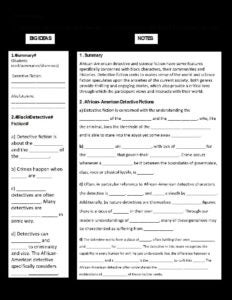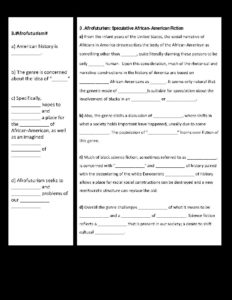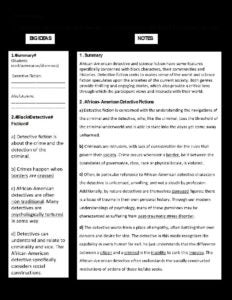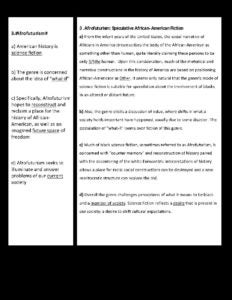Author: Tara Ann Carter
School/Organization:
Hill-Freedman World Academy
Year: 2015
Seminar: Aliens and Others: African Americans [Re]Writing Generic Fiction
Grade Level: 9
Keywords: “The Comet”, African American History, language arts, Literature, Reading, Social Construction, The Walking Dead, W.E.B. Du Bois, writing
School Subject(s): English, Social Studies
This paper seeks to explore methods and shifts in social construction and racial structures in a post-apocalyptic society. Selections from the award-winning television series, The Walking Dead, will be used, in conjunction with W.E.B. Du Bois’ 1920 short story, “The Comet”.
The Walking Dead is a television series acclaimed for its superior acting, story telling and effects. In 2015, the series finished its 6th season and celebrates a wide diversity of viewers. The popularity of this series guarantees buy-in from students and, by extension, enthusiasm and motivation to explore and evaluate it through the framework of social construction.
Download Unit: Carter-Tara-Ann-unit.pdf
Did you try this unit in your classroom? Give us your feedback here.
The Walking Dead is a television series acclaimed for its superior acting, story telling and special effects. In 2015, the series finished its 5th season and celebrates a wide diversity of viewers. Upon conducting an informal poll among my students, over 60% of the student population watches the program on a weekly basis, and 100% of students were, at least, familiar with the premise of the television show. The popularity of this series guarantees buy-in from students and, by extension, enthusiasm and motivation to explore and evaluate it through the framework of social construction. Viewing selected episodes paired with other readings and mediums creates a space in which students can utilize with critical thinking and higher-order processing skills with high-interest, culturally relevant material. One pedagogical study notes, “everyone is affected by mass media in some way or another…the collective effects on society of all these media choices are tremendous” (Tafani 83). Mass media is an inescapable and pervasive element of contemporary society. It is not only pertinent, but also very necessary, to educate students to critically approach all narratives, in all mediums, and the messages they convey.
Objectives
Integrating 21st Century Skills Google Classroom Google Classroom is a self-contained classroom feed, in which the teacher can post announcements, have students upload assignments and share electronic documents, links and much, much more. Each student in the School District of Philadelphia, as well as every teacher, has free access to this program. It is compatible with all operating systems and is also accessible via apps for Android and iPhone. While imperfect in some capacities, the interface is improving rapidly. This is an invaluable tool for teachers whose students have access to a device with Internet capability. ThingLink ThingLink is a multimedia, interactive web based application that allows students to upload an image and create virtual annotations. ThingLink is one example of a multitude of these types of applications, which allow students to interact directly with pieces of art, photographs, primary source documents, etc. Non-Traditional Text Interpretation Students in high school classrooms today are natives of the Information Age. This presupposes an understanding of reading and analysis that is never limited to the printed page. Any medium that conveys a story can be read, including television, photographs, video games and comic books. In particular, when using television as a vehicle for cultural analysis, three concepts are of importance to consider: The cycle of the lessons described below address these considerations in their implementation and the critical lens through which the television show, The Walking Dead, will be viewed. Also, watching television for education purpose creates an opportunity for student to hear model examples of spoken English, which increases the student’s ability to inherently discern the sound of proper grammar (Tafani). Also, this type of engagement can spur further reading and analysis of mass media by the student through encouragement by creation of confidence and interest (Tafini 81). Notes and Information Organization Kloze-Style notes provided a structured frame for students to have a guided listening experience during a brief lecture given by the teacher. On the left side of the notes, the main ideas of each section are summarized, with further detail provided on the right. It is recommended that the teacher dictates each section, followed by a student voice summary and brief discussion of the point outlined in the section previously provided. The fill-in-the-blank style is an easy and efficient way for students to take notes on a topic and its analysis in a guided and systematic manner. Graphic organizers are an exceedingly popular method for students to visually layout and align what they learn. These organizers can be provided by the teacher as a photocopy, drawn on a board for a class creation or students can copy a template into their notebooks. In addition, outline graphic organizers when writing observations and also when planning writing are an important element of informational organization. These practices will increase the concision and focus of language in student’s essays. For this unit in particular, three triangles (3: before/during/after) linked with arrows can be a simple way to students to take notes of power structures as they watch the selections designated to be used during Viewing Days. Another simple graphic organizer that may be of use for this unit could be a t-chart describing social constructions before and after the zombie apocalypse. These lesson enhancements can be simple created in student’s notebooks via pen and paper. Often keeping it simple is the most beneficial way to get something done, graphic organizers included. Writing Workshop Creating a space where students can create and revise a writing piece takes planning and preparation. Teambuilding exercises can be useful to make students comfortable with one another if a strong class dynamic does not already exist. After this tone has been set, students should feel comfortable reading and discussing each other’s writing. They set up appointments, get feedback from multiple peers, and also mock score their classmates work. These activities reinforce understanding of the expectations of the assignment, allow students to model and see models of diverse variety of levels and styles of writing, and create a space for open dialogue about their work. Rubrics can be designed to satisfy individual school requirements and discussed and referenced before, during and after the writing assignment occurs.
Lesson 1: Kloze-Style Structured Notes on Genre Students complete Kloze (fill-in-the-blank) style structured notes while listening to a brief lecture on the generic principles of detective and science fictions, as well as some basics on Afrofuturism. Notes worksheet provided in the Appendix. After students take notes, they will be asked to generate examples and apply lens of generic principles to various movies and television series. To close, students will complete Summary Poem Exit Ticket. Lesson 2: Walking Dead Viewing and Thought Experiment Students view selections from the specified episodes, listed in the chart above, in order, over the course of a week. This period is known as “Viewing Days”. While viewing, students will complete graphic organizers (differentiated by teacher for the needs and abilities of students) to summarize and analyze each episode and the social constructions therein. Suggestions for simple graphic organizers are provided under At the end of each of the Viewing Day, student will complete a journal entry via Google Form, in which they record their own observations and reactions of the episode. After completing the Viewing Days period, students will use their analyses to complete a Speculative Writing Thought Experiment, addressing the prompt: What conditions would have to arise in the US in order for our entire social construction paradigm to be reconfigured? Using paragraph planner graphic organizers and paragraph chunking techniques, students will create a draft of their response to the prompt, incorporating evidence from their viewing notes. Students will then workshop their essays with each other, completing writing checklists and glow/grow feedback t-chart Lesson 3: Art Analysis and Speculation Writing Workshop If students have access to Internet enabled devices, direct them go to the website: http://www.lorinix.net/the_city/index.html If Internet devices are not available, the teacher can print out copies of each picture in advance, or project the images on the screen and complete the activity as a class. Students will view Nix’s photos of deserted urban landscapes. After completing a ThingLink Art Analysis Annotation (procedure and purpose explained in Strategies section above), students will complete a creative story about an object or outside observer of their favorite photo. The following day, as an opener, student should meet with others who wrote about the same picture they chose. Students will share-out creative stories, then turn their attention to comparing apocalyptic potentiality in the photos and in The Walking Dead. Lesson 4: Writing Workshop – Comets vs. Zombies After completing The Walking Dead viewing activities, Students will read W.E.B. Du Bois’ short story “The Comet” and complete Venn diagram comparing the principles of speculative and detective fiction in the two very different considerations of the place of African-Americans in a post-apocalyptic society. After all students have read, a seminar style discussion should be held, in which students discuss the similarities and differences of the two narratives they have examined. As further extension, students could write a constructed response, comparing and contrasting the social construction of the two societies discussed.
Key Episodes and/or Scenes
Season, Episode
Scene
Notes
Season 2, Episode 13
Final two minutes of the episode
This is the first moment we see Michonne in the series. Preview and discuss. This is an excellent place for students to make predictions/inferences
Season 3, Episode 4
Entire episode or fast-forward through to scene with Michonne, if time is a concern
Michonne in the role of detective investigating the new encampment of Woodbury and their leader, The Governor
Season 3, Episode 14
Cold open only
Pieces of Michonne’s past and role in the pre-apocalyptic world begin to surface.
Season 4, Episode 9
Entire episodes or selected scenes with Michonne
Michonne is continually being revealed as a tortured character with a complex past
Season 4, Episode 11
Middle of episode, scenes with Carl and Michonne
Elements of Michonne maternal instincts and compassion begin to show
Season 5, Episode 12
Interview with Deanna and subsequent appointment of Michonne and Rick as joint constables of Alexandria Safe Zone
Deanna as female leader of Alexandria Safe Zone is an interesting social role. Rick, a white male, and Michonne, a black female, share roles of power.
Season 5, Episode 13
Entire episode
Michonne assumes a role of power over Rick, though both she and Rick have been deputized. Michonne is portrayed as in control and stable, whereas Rick is has become illogical and dramatically emotional.
Resources for Teachers “African American Science Fiction.” Ethnic American Literature. Ed. Emmanuel S. Nelson. ABC-CLIO, 43-46. Print. This encyclopedic entry effectively summarizes and provides a concise description of some of the hallmarks of the genre of Afrofuturism. Brooks, Kinitra D. “The Importance of Neglected Intersections: Race and Gender in Contemporary Zombie Texts and Theories.” African American Review Winter 47.4 (2014): 461-75. Project Muse. Web. 1 Apr. 2015. Brooks defines and uncovers spaces for black female bodies in the proliferation of zombie texts in contemporary culture. Butler, Octavia E. Kindred. Boston: Beacon, 2003. Print. In Kindred, the protagonist finds herself being sucked back into time to help the family of Southern planters that owned her people generations before. Weaving historical knowledge, science fiction and social commentary, Butler’s novel is a page-turner with a refined, academic sensibility. Crooks, Robert. “From the Far Side of the Urban Frontier: The Detective Fiction of Chester Himes and Walter Mosley.” College Literature 22.3, Race and Politics: The Experience of African-American Literature (1995): 68-90. JSTOR. Web. 01 Apr. 2015. Crooks examine the urban and racial landscapes of the novels of Chester Himes and Walter Mosley. English, Daylanne K. “The Modern in the Postmodern: Walter Mosley, Barbara Neely, and the Politics of Contemporary African-American Detective Fiction.” American Literary History 18.4 (2006): 772-96. JSTOR. Web. 01 Apr. 2015. English works toward defining the postmodern detective genre thorough an examination of the detective characters Easy Rawlins and Blanche White. Eshun, Kodwo. “Further Considerations of Afrofuturism.” CR: The New Centennial Review 3.2 (2003): 287-302. Project MUSE. Web. 1 Apr. 2015. A foundational text on the genre of Afrofuturism, Eshun posits the hallmarks of the genre as centered on a desire to create and identify a diasporic African historical and cultural identity. Goto-Jones, Chris. “Zombie Apocalypse as Mindfulness Manifesto (after Žižek).” Postmodern Culture 24.1 (2013): n. pag. Project MUSE. Web. 1 Apr. 2015. Goto-Jones conjectures that the quality of mindfulness will be the most valued skill in a post-apocalyptical zombie-infested world. Hobbs, Renee. “Teaching with and about Film and Television: Integrating Media Literacy Concepts into Management Education.” (1998): 1-17. ERIC. Web. 1 May 2015. Hobbs explains the pros and cons of using television as an instructional tool and creates a framework with which to approach analyzing and discussing television that is selected for instructional use. Lauro, Sarah Juliet, and Karen Embry. “The Zombie Manifesto: The Nonhuman Condition in the Era of Advanced Capitalism.” Boundary 2 Spring 35.1 (2005): 85-108. Print. The Zombie Manifesto is an introductory work on the generic contextualization of the proliferation of zombie narratives in contemporary society. The authors explain that reading the zombie as a metaphor response provides a framework to approach the overwhelming popularity of the theme. Lock, Helen. “Invisible Detection: The Case of Walter Mosley.” MELUS 26.1 (2001): 77-89. JSTOR. Web. 1 May 2015. Lock identifies the elements and contexts of the characters in Walter Mosley’s characters. Lock claims the racialized experiences of black bodies are capitalized upon and defined by Mosley in his novels. Moreman, Christopher M., and Corey James Rushton, eds. Zombies Are Us: Essays on the Humanity of the Walking Dead. Jefferson, NC: McFarland, 2011. Google Books. 21 Sept. 2011. Web. 1 Apr. 2015. A varied collection of philosophical essays on the interest, involvement, and speculation of zombie narratives and our society. Mosley, Walter. Devil in a Blue Dress. New York: Norton, 1990. Print. Devil in a Blue Dress is the first book in the now infamous Easy Rawlins detective fiction series. This novel introduces Easy, Mouse and other key characters that will develop over the course of the serialization. The psychology of the African-American detective is made explicit here through the characterization of Rawlins provided by Mosley. Smith, Darryl A. “Droppin’ Science Fiction: Signification and Singularity in the Metapocalypse of Du Bois, Baraka, and Bell.” Science Fiction Studies Afrofuturism 34.2 (2007): 201-19. JSTOR. Web. 01 Apr. 2015. This article is useful for this course of study only in that it has some discussion on critical viewpoints of Du Bois’ The Comet, which is a suggested comparative text to The Walking Dead in this unit. Tafani, Vilma. “Teaching English Through Mass Media.” Acta Didactica Napocensia 2.1 (2009): 81-95. Print. The author discusses various sources of mass media, the importance of this type of non-traditional textual study and suggestions for lesson planning and activity implementation. Yaszek, Lisa. “Race in Science Fiction: The Case of Afrofuturism and New Hollywood.” A Virtual Introduction to Science Fiction. Ed. Lars Schmeink. Web. 2013. 1-11. Yasek constructs an argument for the intersection of race and science fiction. She identifies some generic principles of Afrofuturism and traces the history of the genre from the 1920s to the present. Resources for the Classroom Adlard, Charlie, Frank Darabont, Robert Kirkman, and Tony Moore. “Seasons 1 – 5.” The Walking Dead. AMC. 2010 -. Television. The award-winning, virally popular television series The Walking Dead imagines a future world, where a zombie infestation has overtaken the reachable world. Du Bois, W.E.B. “The Comet.” Dark Matter: A Century of Speculative Fiction from the African Diaspora. Ed. Sheree R. Thomas. New York: Warner, 2000. 5-18. Print. A 1920 short story, which paints an apocalyptic vision of a thriving New York City sedated by the gaseous fumes of a passing comet. Two survivors, a white woman and a black man, meet by chance. Du Bois’ narrative magnifies the anxieties of the time period about race and also social norms. This text is an anchor to this unit and one of the earliest examples of Afrofuturistic writing. Nix, Lori. 2013. The City, Http://www.lorinix.net/the_city/index.html. Lori Nix: The City. Lori Nix. Web. 5 Apr. 2015. Lori Nix is a contemporary photographer who specializes projects with themes of desolation and the erosion of civilization by nature. Her project, The City, examines scenes of visualized destruction in a post-civilized society. “ThingLink: Make Your Images Interactive.” Thinglink. Web. 01 Apr. 2015. An interactive multimedia annotation web-based platform used to annotate and digitally interact with photos and primary source documents
Generic Conventions Kloze-Style Structured Notes Worksheet and Key



Pennsylvania Common Core Standards This unit seeks to address and satisfy the changing nature of literacy instruction under the Common Core standards that are now in the process of being adopted nationwide. Specifically, in English Language Arts there is a major focus on the need for students to be able to read a variety of texts, in various formats, as well as, the practice of argumentative writing with supporting evidence. Emphasis on these skills is the foundation of this unit. Listed below are the standards that the various activities within this unit will satiate: CC.1.2.9–10.C Apply appropriate strategies to analyze, interpret, and evaluate how an author unfolds an analysis or series of ideas or events, including the order in which the points are made, how they are introduced and developed, and the connections that are drawn between them. CC.1.3.9–10.B Cite strong and thorough textual evidence to support analysis of what the text says explicitly, as well as inferences and conclusions based on an author’s explicit assumptions and beliefs about a subject. CC.1.3.9–10.C Analyze how complex characters develop over the course of a text, interact with other characters, and advance the plot or develop the theme. CC.1.3.9–10.A Determine a theme or central idea of a text and analyze in detail its development over the course of the text, including how it emerges and is shaped and refined by specific details; provide an objective summary of the text. CC.1.3.9–10.G Analyze the representation of a subject or a key scene in two different artistic mediums, including what is emphasized or absent in each treatment. of strategies and tools. CC.1.3.9–10.K Read and comprehend literary fiction on grade level, reading independently and proficiently CC.1.4.9–10.B Write with a sharp, distinct focus identifying topic, task, and audience. CC.1.4.9–10.C Develop and analyze the topic with relevant, well-chosen, and sufficient facts, extended definitions, concrete details, quotations, or other information and examples appropriate to the audience’s knowledge of the topic; include graphics and multimedia when useful to aiding comprehension. CC.1.4.9–10.D Organize ideas, concepts, and information to make important connections and distinctions; use appropriate and varied transitions to link the major sections of the text; include formatting when useful to aiding comprehension; provide a concluding statement or section. CC.1.4.9–10.M Write narratives to develop real or imagined experiences or events.